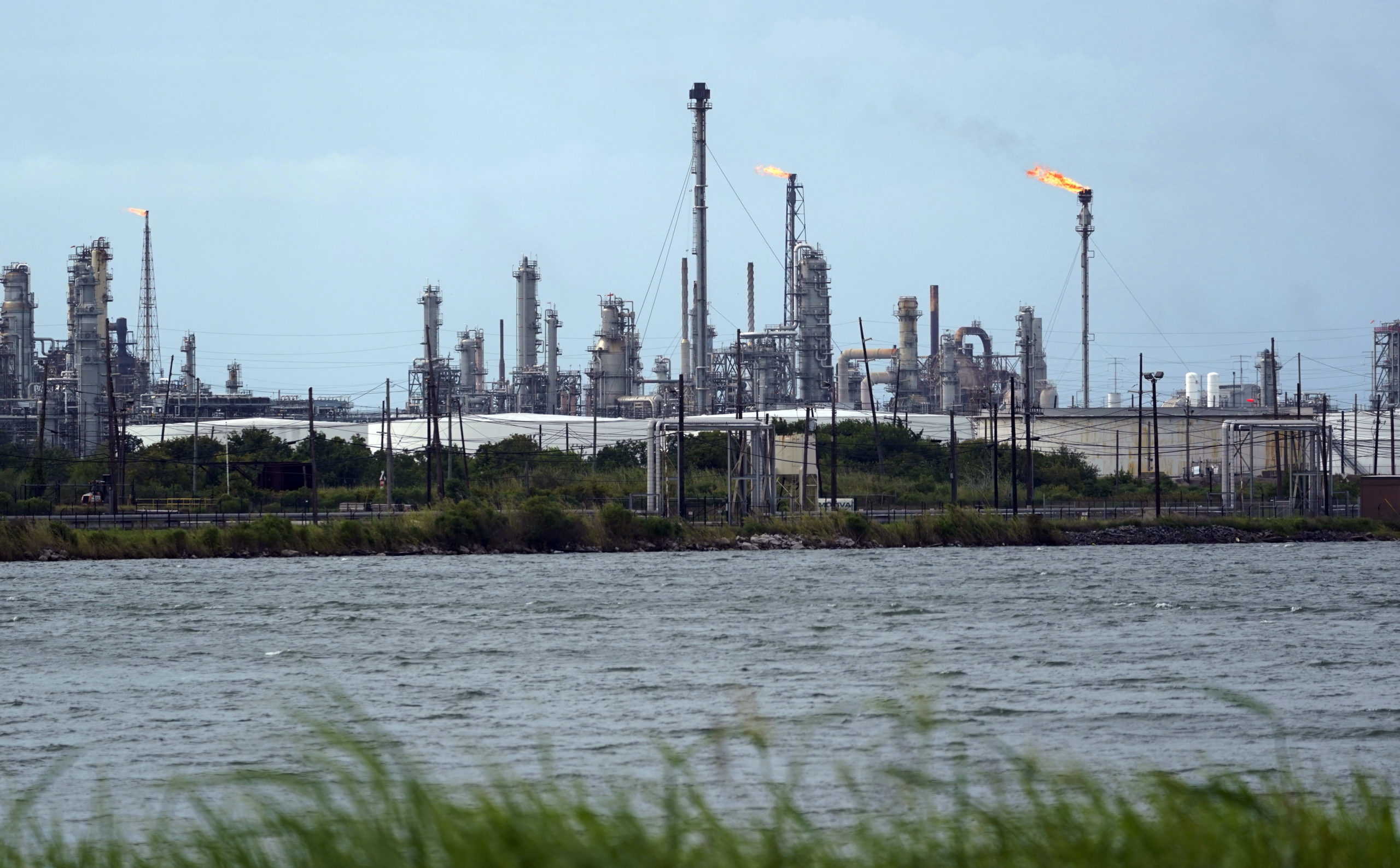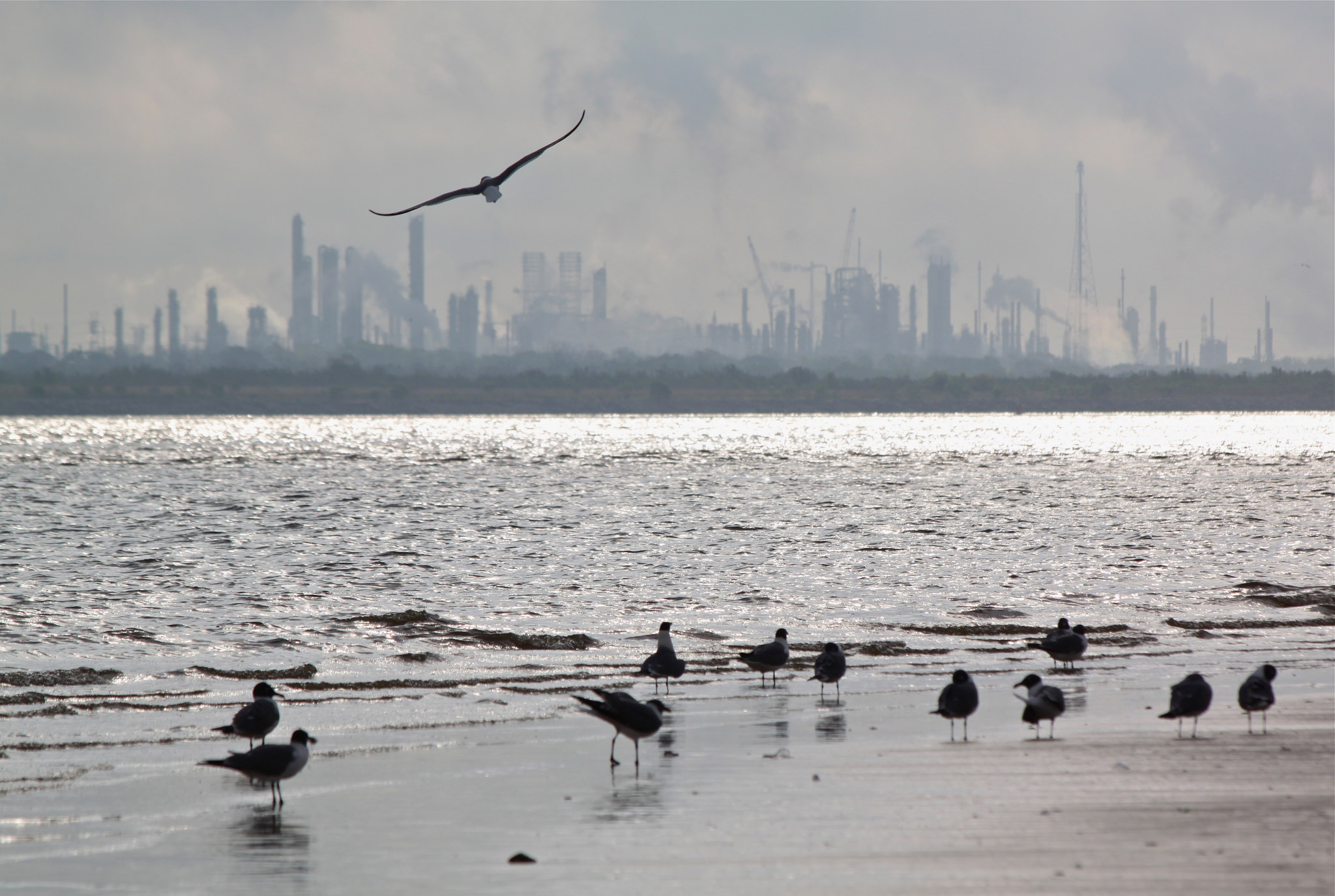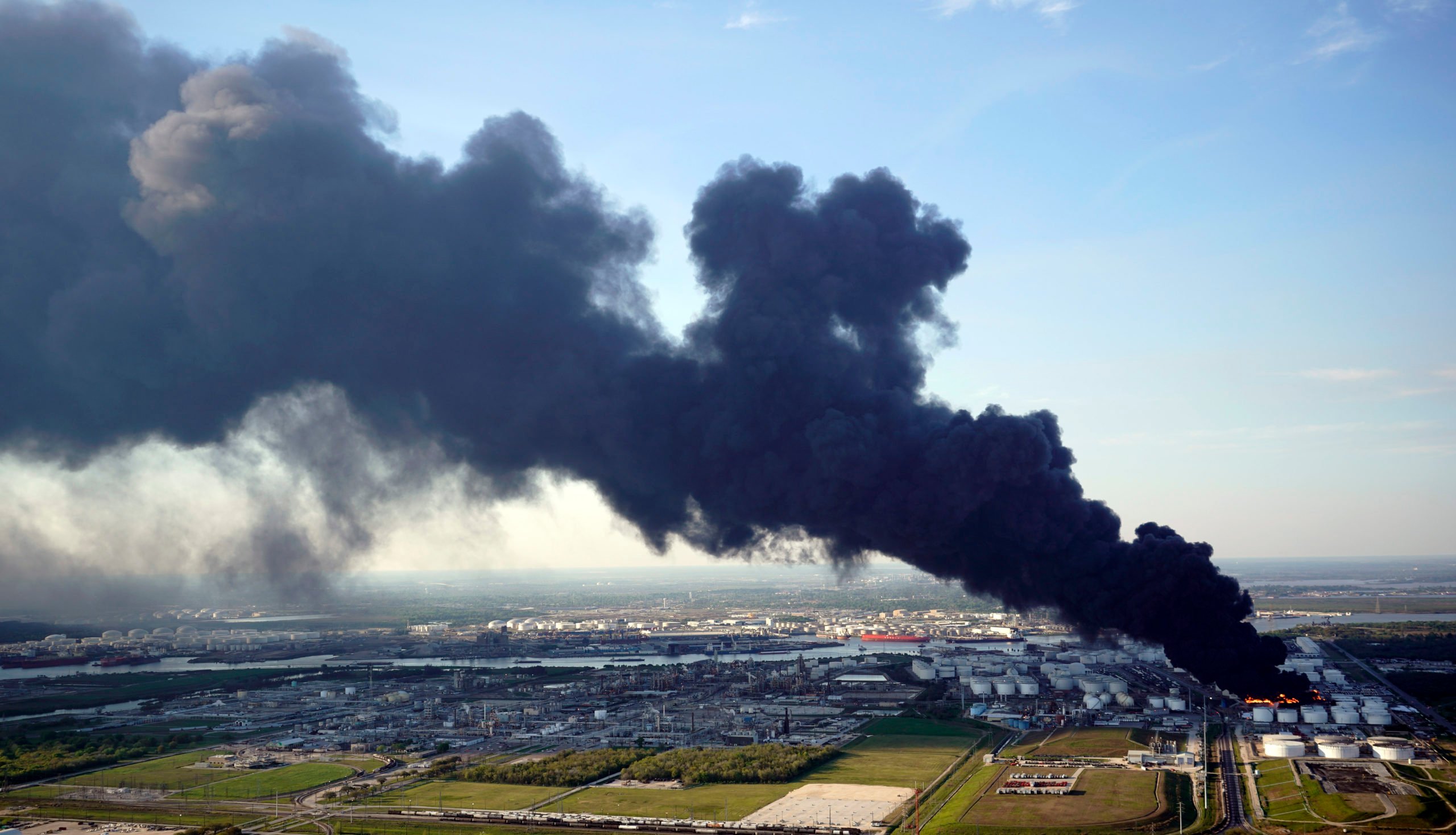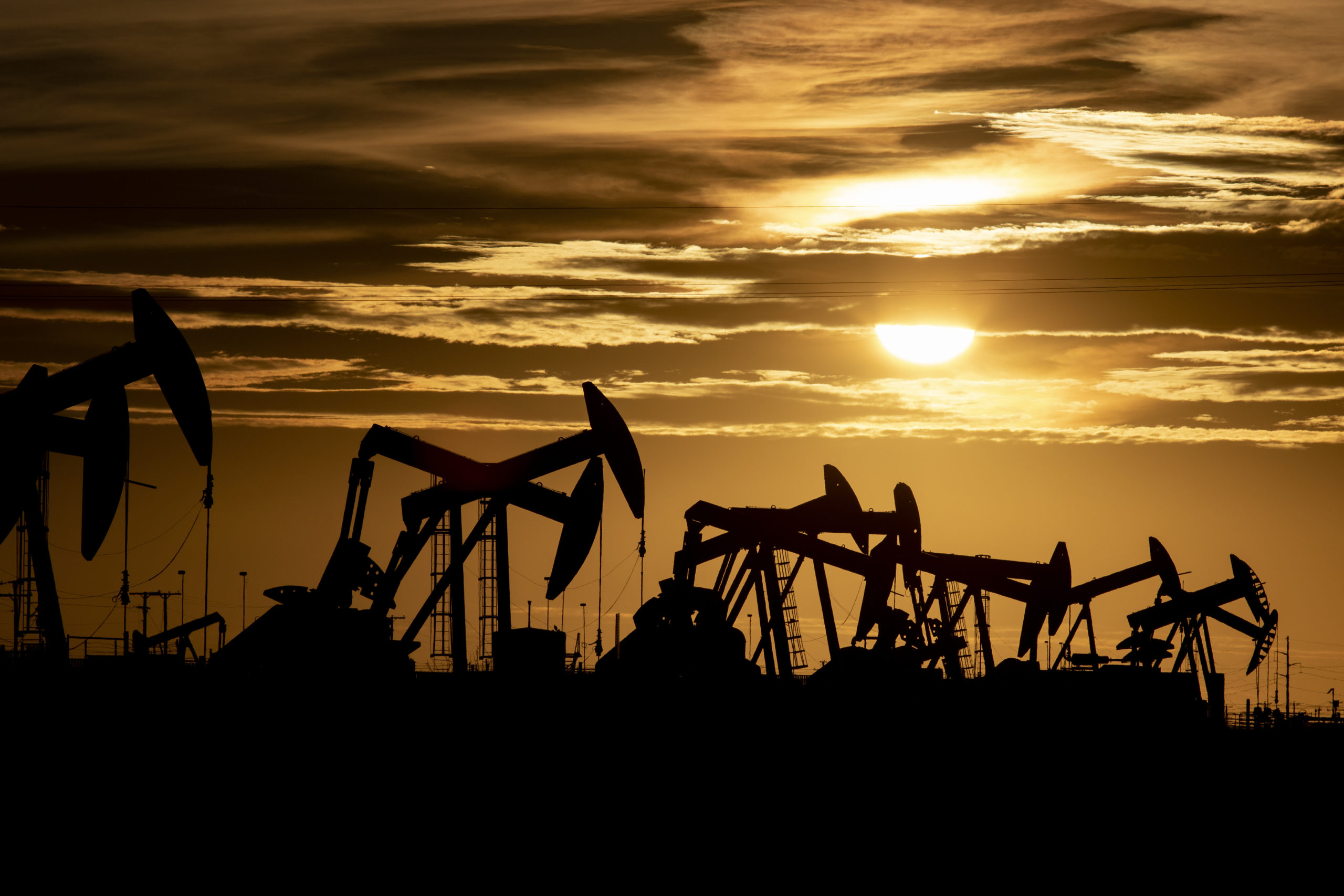
Industrial Facilities Released Millions of Pounds of Illegal Pollution During the Winter Storm
Many of them won’t face any consequences for the excess emissions that they pumped into the air, endangering the lives of communities downwind.

When the lights went off during the winter storm last month in Galena Park, a city of 10,000 people on the east side of Houston, an eerie orange glow emanated from across the bayou that borders its southern edge as the refineries that line the Ship Channel lit up the night sky. Chemical plants and refineries which hadn’t shut down in preparation for the brutal cold of the February 15 winter storm, and the massive power outages it triggered, burned off thousands of pounds of dangerous and unprocessed chemicals as they rushed to shut down during the emergency.
Over the course of the week-long winter storm in mid-February, industrial plants statewide emitted more than 3 million excess pounds of pollution, according to an independent analysis by the Environmental Defense Fund, Air Alliance Houston, and Environment Texas. After Hurricane Harvey, for comparison, plants along the Gulf Coast emitted 1 million pounds of excess pollution. The process is like an out-of-control pressure cooker: chemicals and gasses had to be let out of the facility before the power went out, or the whole plant could explode.This led to massive amounts of air pollution that far exceed the volume that the plants have permits for.
Juan Flores, a resident of Galena Park who works for Air Alliance Houston, an environmental advocacy group, knows that this time, his neighborhood was lucky. “You could see the flaring, you could hear it, like a buzzing sound coming from the channel,” he says. “But the winds were blowing into the south.” Galena Park residents, trapped in their homes because of the icy roads and power outages, couldn’t smell the toxic chemical soup that was wafting out of the Ship Channel. Instead, the fumes were blown into Pasadena.
“There was a really nasty smell,” says Pat Gonzales, the director of an environmental advocacy group called Caring For Pasadena Communities. “It gives people headaches and nausea, especially for people with compromised immune systems.”
Nearly a fifth of the pollution during Winter Storm Uri occured in the Houston area. Statewide, 54 counties experienced some level of dangerous, excess pollution. It typically takes several days to safely shut down industrial plants without excess pollution. But refineries didn’t start to shut down until power outages were imminent. So from Corpus Christi to Port Arthur, they began burning off chemicals like benzene, methane, nitrogen oxides, and butane, all harmful carcinogens that can cause a myriad of health issues. Emissions also increased in every major oil field in the state, as drillers in the West Texas Permian Basin, South Texas’ Eagle Ford Shale, and the Barnett Shale in North Texas flared off natural gas that they couldn’t store or transport as pipelines started to freeze.
If the past is any indicator, many of these facilities won’t face any consequences for the excess emissions that they pumped into the air, endangering the lives of communities downwind. Some were repeat offenders from Hurricane Harvey, says Catherine Fraser, a clean air advocate at Environment Texas.
While these facilities are required to self-report emissions violations to the Texas Commission on Environmental Quality, the agency rarely issues fines or citations. Companies often use a loophole known as “affirmative defense” to claim that the emissions from hastily shutting down their plants was unavoidable and unpredictable. In 2017, the year that Harvey hit, polluters invoked the affirmative defense loophole in 97 percent of emission events. The Texas Commission on Environmental Quality (TCEQ) issued fines in 56 out of 4,000 cases. But with most natural disasters, there’s a window of time to prepare, even if companies claim otherwise. That was certainly true during Hurricane Harvey, although it’s unclear if companies knew of the risk of power outages during the winter storm beforehand. Valero, which operates a refinery between Galena Park and Pasadena, didn’t respond to a request for comment.
“Oftentimes, what we see is that it’s more economical to keep producing, because penalties are so low,” Fraser says. “It’s cheaper to potentially violate the law than to comply.”
Democratic lawmakers filed two bills in the Texas Legislature this year that could finally change that. State Representative Erin Zwiener’s House Bill 1820 would increase the fines that TCEQ can levy from a cent per pound of pollution to $1. State Senator Cesar Blanco’s bill would go a step further, eliminating the affirmative defense loophole altogether. “Allowing companies to continue to pollute without any repercussions has a lasting impact on Texans’ health,” Blanco said in a statement. “There needs to be a way for the Commission to ensure that companies took the proper steps to prepare their facilities for the expected weather.”
Both bills will face an uphill battle in the regulation-averse, Republican controlled legislature. Absent any regulation, when these facilities choose to shut down improperly and emit excess pollution, the cost is often borne by the communities that breathe in the polluted air. According to one report, 10 percent of African Americans in Texan live within a half-mile of oil and gas facilities, and the rates of cancer in those communities are above average. Near the Houston Ship Channel, Latinx communities like Galena Park and Pasadena are disproportionately impacted.
Year-round exposure to pollution from these plants has caused high rates of asthma and other respiratory issues, which are exacerbated during air pollution spikes. Longtime residents by the Ship Channel are accustomed to flares during natural disasters and plan accordingly. “I’ve heard of people just leaving the area [before a hurricane] in some cases,” Flores says. For those who tried to wait out Harvey, there was nowhere to go once the floodwaters started to rise. When the fumes reached their homes, Flores says, “All we could do was sit here and take it.”
In Pasadena, during the winter storm, companies didn’t give residents any warning about who was downwind from the flares, Gonzales says. As families lost power and running water, they weren’t tracking wind patterns to figure out if they needed to evacuate from the plumes of carcinogens from the Ship Channel. Weeks after the storm, she still hasn’t heard from anyone at TCEQ or the refineries about the full extent of the potential harm residents may have faced. According to the federal Environmental Protection Agency, 39 of TCEQ’s air monitoring stations lost power during the storm.
In the zipcode that Bryan Parras lives in near the refineries, COVID-19 has hit the community of about 37,000 residents hard. Since last year, 57 people have died, and close to 4,000 have tested positive for the virus. Researchers have found that the air pollution that residents breathe can make the virus more deadly as it attacks the respiratory system of its victims. “We have so many overlapping illnesses in this community,” says Parras, an environmental advocate with the Sierra Club. Days before the storm hit, he was working to get community members registered for coronavirus vaccine appointments. By February 15, he was dropping off generators for residents who had lost power and had no way to keep their oxygen machines running.
“People are beginning to understand that the world we live in is going to include these natural disasters every year,” he says. “It’s exhausting. But we are learning to do what we can for ourselves and our loved ones.”
Read more from the Observer:
-
A Texas City Had a Bold New Climate Plan—Until a Gas Company Got Involved: The fossil fuel industry is using the same playbook to fight city climate plans around the country.
-
Portraits of the Pandemic—Part Two: Last summer, we talked to nine Texans about their experiences with COVID-19. Now, we check back in with those folks—and hear from a few new ones—who have graciously shared their stories.
-
Planned Parenthood Returns to Lubbock: In an effort to defund Planned Parenthood, state leaders have dismantled Texas’ reproductive health care safety net over the last decade. This fall, the provider reopened a clinic in a mostly rural, Republican part of the state.


